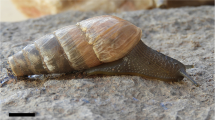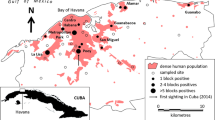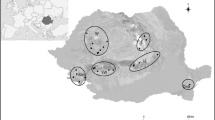Abstract
Central Europe faces an influx of terrestrial invertebrates from more southerly regions, in particular from the Mediterranean. This process is particularly noticeable among terrestrial gastropods. In the last 30 years, the number of non-native land snail species found outdoors in the Czech Republic increased from 5 to 15 (8% of all species); more than half of these have presumed Mediterranean origin. The trend has accelerated recently; seven new alien species (six Mediterranean) have been recorded since 2000. As the most recent example, we report the finding of a large helicid species from the South-East Mediterranean, Helix lucorum. A well-established overwintering population was found in Prague, over 400 km from the nearest known localities of the species. This trend of newly established snails corresponds with increases in average temperatures as well as the intensity of foreign trade in the past six decades, suggesting a synergistic effect of both climatic conditions and socioeconomic factors.

Similar content being viewed by others
References
Aubry S, Labaune C, Magnin F, Roche P, Kiss L (2006) Active and passive dispersal of an invading land snail in Mediterranean France. J Anim Ecol 75:802–813
Benke M, Renker C (2005) Vorkommen von Monacha cartusiana (O. F. Müller, 1774) und Cernuella neglecta (Draparnaud, 1805) im Stadtgebiet von Leipzig (Sachsen). Malakol Abh 23:109–115
Buschmann H, Keller M, Porret N, Dietz H, Edwards PJ (2005) The effect of slug grazing on vegetation development and plant species diversity in an experimental grassland. Funct Ecol 19:291–298
Cowie RH (1985) Microhabitat choice and high temperature tolerance in the land snail Theba pisana. J Zool Lond (A) 207:201–211
Dobrovolný P, Moberg A, Brázdil R, Pfister C, Glaser R, Wilson R, Van Engelen A, Limanówka D, Kiss A, Halíčková M, Macková J, Riemann D, Luterbacher J, Böhm R (2010) Monthly, seasonal and annual temperature reconstructions for Central Europe derived from documentary evidence and instrumental records since AD 1500. Clim Change 101:69–107
Fischer W, Duda M (2004) Beiträge zur Kenntnis der Molluskenfauna Österreichs VII. Cernuella virgata (da Costa 1778), neu für die Molluskenfauna Wiens, sowie Bemerkungen zur Ausbreitung von Monacha cantiana (Montagu 1803), Cernuella neglecta (Draparnaud 1805), Hygromia cinctella (Draparnaud 1801) und Cornu aspersus (O. F. Müller 1774) in Niederösterreich und Wien (Mollusca: Gastropoda). Nachrbl Erst Vorarlberg Malakol Ges 12:10–14
Godan D (1983) Pest slugs and snails, biology and control. Springer, Berlin
Hlaváč JČ, Peltanová A (2010) First occurrence of Kentish snail Monacha cantiana (Mollusca: Gastropoda: Hygromiidae) in the Czech Republic. Malacol Bohemoslov 9:11–15
Horsák M, Juřičková L, Beran L, Čejka T, Dvořák L (2010) Komentovaný seznam měkkýšů zjištěných ve volné přírodě České a Slovenské republiky [Annotated list of mollusc species recorded outdoors in the Czech and Slovak Republics]. Malacol Bohemoslov Suppl. 1:1–37
Jaremovic R, Rollo D (1979) Tree climbing by the snail Cepaea nemoralis (L.): a possible method for regulating temperature and hydration. Can J Zool 57:1010–1014
Juřičková L (2006) Mollusca. In: Mlíkovský J, Stýblo P (eds) Nepůvodní druhy fauny a flóry České Republiky [Non-indigenous fauna and flora of the Czech Republic]. AOPK ČR, Praha, pp. 214–215 [in Czech]
Juřičková L, Kapounek F (2009) Helix (Cornu) aspersa (O.F. Müller, 1774) (Gastropoda: Helicidae) in the Czech Republic. Malacol Bohemoslov 8:53–55
Lockwood J, Hoopes M, Marchetti M (2007) Invasion ecology. Blackwell, Oxford
Ložek V (1964) Quartärmollusken der Tschechoslowakei. ÚÚG, Praha
Mienis HK, Rittner O (2010) On the presence of Helix lucorum Linnaeus, 1758 (Mollusca, Gastropoda, Helicidae) in Le Vesinet, a western suburb of Paris. MalaCo 6:266–267
Pyšek P, Jarošík V, Hulme PE, Kühn I, Wild J, Arianoutsou M, Bacher S, Chiron F, Didżiulis V, Essl F, Genovesi P, Gherardi F, Hejda M, Kark S, Lambdon PW, Desprez-Loustau M-L, Nentwig W, Pergl J, Pobolšaj K, Rabitsch W, Roques A, Roy DB, Shirley S, Solarz W, Vilà M, Winter M (2010) Disentangling the role of environmental and human pressures on biological invasions across Europe. Proc Natl Acad Sci USA 107:12157–12162
Rabitsch W (2006) Arion vulgaris. DAISIE. http://www.europe-aliens.org/pdf/Arion_vulgaris.pdf. Last accessed 15 Nov 2010
Rabitsch W (2008) The times they are a-changin’: driving forces of recent additions to the Heteroptera fauna of Austria. In: Grozeva S, Simov N (eds) Advances in Heteroptera research. Festschrift in honour of 80th anniversary of Michail Josifov. PenSoft, Moscow, Sofia, pp 309–326
Říhová D, Juřičková L (2011) The Girdled Snail Hygromia cinctella (Draparnaud, 1801) new to the Czech Republic. Malacol Bohemoslo 10:35–37
Roques A, Rabitsch W, Rasplus J-Y, Lopez-Vaamonde C, Nentwing W, Kenis M (2009) Alien terrestrial invertebrates of Europe. In: Drake JA (ed) Handbook of alien species in Europe. Springer, New York, pp 63–80
Schutyser F, Condé S, Hoogeveen Y (eds) (2009) Progress towards the European 2010 biodiversity target. EEA Report
Tilling SM (1986) Activity and climbing behaviour: a comparison between two closely related landsnail species Cepaea nemoralis (L.) and C. hortensis (Müll.). J Mollus Stud 52:1–5
Varga A, Gergely K, Sulyok KM (2010) A Cornu aspersum (O. F. Müller, 1774) és a Helix lucorum Linnaeus, 1758 adventív csigafajok hazai előfordulásának aktualizálása. (New distribution records of Cornu aspersum (O. F. Müller, 1774) and Helix lucorum Linnaeus, 1758 in Hungary). Malakológiai Tájékoztató 28:85–90 [in Hungarian, English abstract]
Walther G-R, Roques A, Hulme PE, Sykes MT, Pyšek P, Kühn I, Zobel M, Bacher S, Botta-Dukát Z, Bugmann H, Czúcz B, Dauber J, Hickler T, Jarošík V, Kenis M, Klotz S, Minchin D, Moora M, Nentwig W, Ott J, Panov VE, Reineking B, Robinet C, Semenchenko V, Solarz W, Thuiller W, Vilà M, Vohland K, Settele J (2009) Alien species in a warmer world: risks and opportunities. Trends Ecol Evol 24:686–693
Yildirim MZ (2004) Edible snails (terrestrial) of Turkey. Turk J Zool 28:329–335
Acknowledgments
This study was supported by projects of the Czech Ministry of Education (MSM0021620828 and MSM6293359101) and the Czech Ministry of Culture (MK00002327201). The first author thanks her husband Tomáš Peltan, who, despite being an architect, first recognized that the snail population in question is exceptional. Two anonymous referees provided comments that improved the previous version of the manuscript.
Author information
Authors and Affiliations
Rights and permissions
About this article
Cite this article
Peltanová, A., Petrusek, A., Kment, P. et al. A fast snail’s pace: colonization of Central Europe by Mediterranean gastropods. Biol Invasions 14, 759–764 (2012). https://doi.org/10.1007/s10530-011-0121-9
Received:
Accepted:
Published:
Issue Date:
DOI: https://doi.org/10.1007/s10530-011-0121-9




